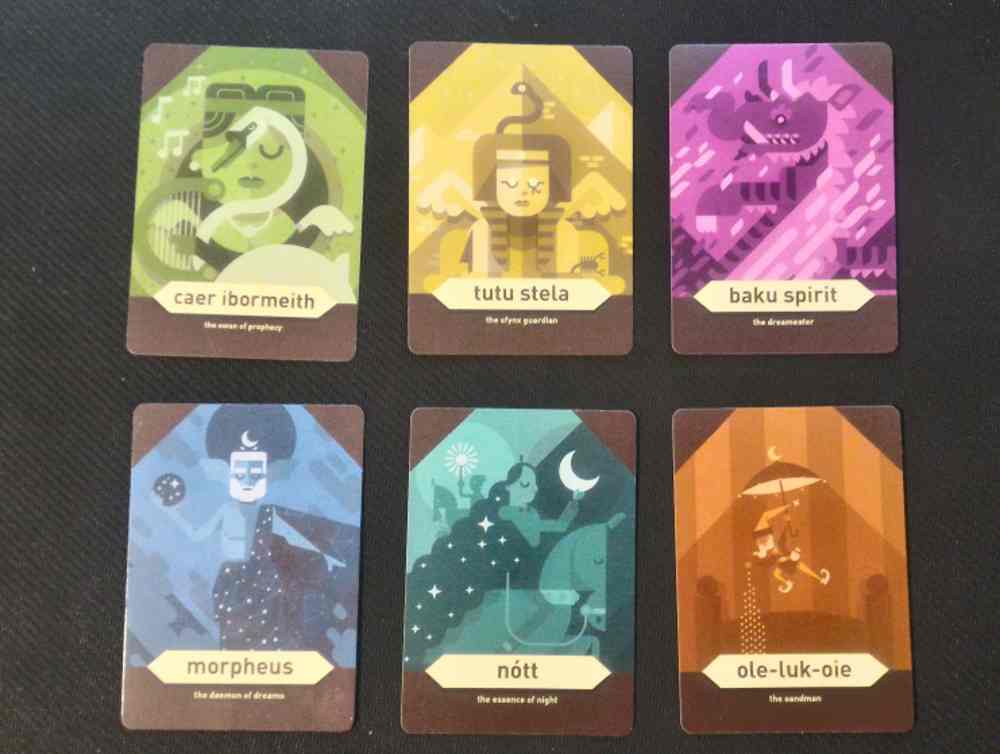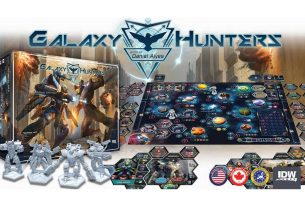
Dreamcatcher is a strategic, push your luck, card game for 2-6 players. It takes its theme from sleep myths around the globe. The game is suitable for players around aged 8 upwards. The more players you have the more interesting the game. Games last 15-30 minutes depending on how many people are playing.
The game is looking for funding on Kickstarter now.
New to Kickstarter? Check out our crowdfunding primer, and visit our Kickstarter curated page for more projects we love.
What is Dreamcatcher?
Dreamcatcher is a themed card game featuring dreams and nightmares. It has a prisoner’s dilemma mechanic, where the rewards can be great if you double-cross your opponents but negative if you try to trick one another at the same time.
Each player takes on the role of a divine entity who guards the realm of dreams. They do so with a deck of “Dream God” cards. Players receive 12 numbered “Dream Power” cards and additional “Cheat Destiny” and “Face Your Fear” cards that are used in the course of the game. For a more advanced game, each Dream God deck has a unique “Divine Inspiration” that can be used once per game.
During a game, cards are dealt face up from a Nightmare pile which players then compete to win. This is done by being the player who reveals the highest numbered Dream Power card. But beware, if your opponent reveals their Cheat Destiny card, you may have exhausted your powers for nothing.
Play continues until all Dream Power cards have been used up, and whoever collected the most Nightmare points wins.
What’s in the box?
Note: I was sent a prototype version of the game and the final components/rules of the game may be different.
A standard pledge level of €20 (approx $24) will bring you a box containing 162 cards. These are:
1 First Dreamer Cards.
- 48 Nightmare Cards.
- 23 Dream Cards.
- 12 X 6 (12 Per Player) Dream Power Cards.
- 6 (1 per player) Cheat Destiny Cards.
- 6 (1 per player) Face Your Fear Cards.
- 6 (1 per player) Unique Divine Inspiration Cards.
- Rules.
How do I play Dreamcatcher?
Game set up:
- Shuffle the Nightmare deck and place it face down on the table.
- Shuffle the Dreams deck and place it face down next to the Nightmare deck.
- Each player gets a set of Dream God cards and a Divine Intervention card. (Don’t play with the Divine Intervention cards in your first games.)
- The player who last had a nightmare goes first and receives the first player card.

Play overview:
Each turn a number of Nightmare cards are turned over. The number of cards turned over is always less than the number of (active) players in the game. (Players can drop out of the game early, in which case the numbers of Nightmare cards drawn each turn may change.)
Nightmare cards have numbers on them that range from 2-8. The higher the number, the more points the card scores. Players then compete to win Nightmare cards, by outbidding one another with their Dream Power cards. It is possible to be the only person bidding on a Nightmare, but with there always being at least one less Nightmare than players, there will always be some competition for cards.
Reducing the game to it simplest aspect, players simultaneously reveal which Dream Power card they have used. The highest Dream Power card played on a Nightmare subdues it and that player wins the card.
Play continues until all Dream Power cards have been used up. At which point, each player totals the number of Nightmares they subdued. The highest total wins the game.
But there’s more to it than that…
With all players starting with Dream Power cards of value 1-12, you can immediately see that the timing of when you play your cards is important. You want to maximize the value of your cards by winning by the smallest majority.
When placing your Dream Power card (face down), you also choose whether to “Face your Fears” or “Cheat Destiny.” You place one of these cards (also face down), alongside your Dream Power card.
The playing of Dream Power cards (with Cheat Destiny or Face you Fears) starts with the player with the First Player Token and continues around the table.
Once all players have placed their cards, they are simultaneously revealed.
How things play out now depends on what each player decided to do.
- If you were the only player to play on a Nightmare card and you played a Face Your Fears card. Congratulations! You win the card.
- If more than one player played on a Nightmare card and they all Faced Their Fears, the player who played the highest Dream Power card wins the Nightmare Card. Note: Runners-up all receive a green Dream card for being so brave (more on those later). In the event of a tie, there is no winner; all tying players take a Dream Card. The Nightmare is discarded.
- If more than one player played on a Nightmare card and at least one (but not all) players attempted to Cheat Destiny, a player that cheated destiny will steal the Nightmare. The player who played the highest Dream Power card along with Cheat Destiny wins the card. (Note: Players who were brave and Faced Their Fears will receive a Dream card. Players who Cheated Destiny but still lost out receive nothing. In the event of tie, nobody wins.)
You can immediately see that judicious use of your Cheat Destiny card means you can win with your low numbered Dream Power cards. There is, of course, a catch.
- If ALL players played Cheat Destiny Cards, NOBODY wins the Nightmare card. Instead, the person who played the lowest Dream Power card has to randomly discard a Dream Power card from their hand. This means that they will not be able to contest a Nightmare later in the game, as they will have fewer cards than other players. In the event of a tie, nothing happens.
- If you are the only player playing on a Nightmare and you Cheated Destiny you have really shot yourself in the foot.
After the round, Dream Power cards played are discarded. Cheat Destiny/Face Your Fears cards are returned and a new round can begin.
The first player card moves in an anti-clockwise fashion. So the player who had the advantage of playing last in the previous turn (and therefore may have had the opportunity to play on an empty Nightmare card) plays first in the next turn.

What are Dream Cards for?
Dream Cards are won each time you Faced your Fear but weren’t lucky enough to win the Nightmare card. They are a consolation prize, but they do have their uses. Each Dream Card has a number on it, 1-3.
These can be used to score extra points at the end of the game by adding them to your Nightmare score. Alternatively, you can use them to secretly boost your Dream Power cards. You can play them face down with your Dream Power cards adding the two values together when resolving who wins the Nightmare card. They can be a great way of boosting you into a winning position or fooling your opponent into thinking that’s what you’re trying to do. Note: You can play any number of cards when trying to subdue a Nightmare, either Dream cards or Dream Power cards. The problem with using an extra Dream Power card is that you’re more likely to run out before your opponents, giving them a free choice at the end of the game.

What are Divine Inspiration cards?
Each player is given a unique Divine Inspiration card. It’s a little trick, special to the Dream God you represent that you can use to influence the game. But choose your time wisely. Divine Inspiration can only strike once per game!
Should you show your discard pile?
As the game progresses, each player will have an increasing number of cards discarded. The values of these cards become increasingly important as middle order cards can become the highest on the table. In its purest form, I guess it’s desirable that players’ discards remain face down, making you remember which cards your opponents have used up. When learning to play, or playing with younger players, I’ve found it best to play with the discard open. It means players can more easily concentrate on the central (more fun) elements of the game, rather than trying to count everybody else’s cards.
What is gameplay like?
Fun! The competing elements of the game are simple to understand and entertaining in practice. With each player trying to win their nightmares as cheaply as possible, each round becomes an exercise in psychological warfare. The prisoner’s dilemma continually gives you plenty to think about. Should you go all out to win the highest scoring card, or pick up a lower point card, with little danger? Adding in Dream cards to the mix muddies the waters further. Much like Coup and Love Letter, Dreamcatcher is quick to play and will have you whooping in triumph one moment and howling in despair the next.
Games are definitely more fun with more people playing. The two-player game is a diverting 10 or 15 minutes, but with 4, 5, or 6 players, the game becomes a cacophony of deceit and betrayal. My children have enjoyed this game, though only in a gentle fashion. Best to go easy on the double-crossing!
Why should you back Dreamcatcher?
I like games that evolve as you play them, and invoking the prisoner’s dilemma does exactly that. Just because the people you’re playing have tended to do a certain thing in a given situation doesn’t mean they always will. Games and strategies are always evolving. What this means is that, yes, you’re playing Dreamcatcher, but what it boils down to is you’re in a battle of wits against your opponents. Your friends.
Each time you pull out Dreamcatcher, you’re in for a different experience, depending on how well you know the other players, how often you’ve played the game, or if you took out their 12 card for the cost of a 1 in the previous game. The artwork and theme are lovely. I love the simple but striking infographic style and the dream-themed decks work very well. All in all, a few hands of Dreamcatcher is a great way to spend time with friends, get inside their minds and become their worst nightmare – somebody who tricks them every time!
Check out the Dreamcatcher Kickstarter here.
Click here to see all our tabletop game reviews.
Disclosure: GeekDad received a copy of this game for review purposes.




Hey man I just launched a new Kickstarter and it’s been a while since I’ve done so, the last one I had was Automagic Tiles which turned into a cool product 🙂 I was hoping you would give me a shout out, i’ve got 30 days to fund this little side project I was working on and some feedback at the very least would be awesome! Thanks!
https://www.kickstarter.com/projects/sessionzero/truly-wild-magic-random-magic-effect-cards?ref=user_menu